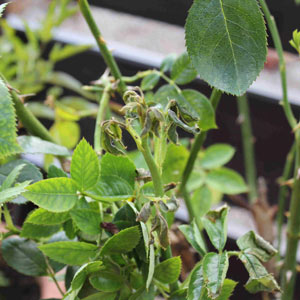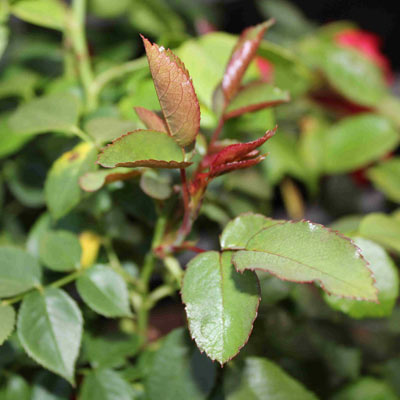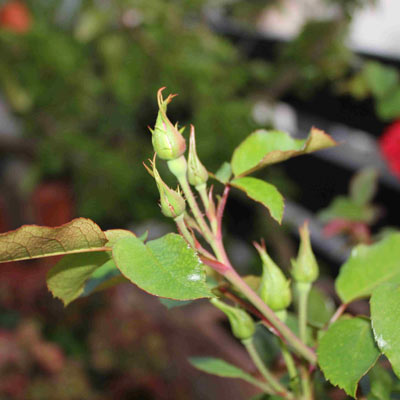|
Camphora: Ants
Ants become pests when they are
cultivating aphids on plants in order to regularly “milk” them i.e. to consume
their sweet excretions. This is what happened last year in May/June in Ms S.
P.´s greenhouse, where several ant nests could be seen and the aconite was
covered in black aphids. She was really surprised when the ants and the aphids
disappeared the day after she applied a single dose of Camphora
30 C; she had used a watering can to thoroughly douse the plants and the ant
nests with a solution of the remedy.
Her father had a similarly positive
experience using Camphora
30 C for a raised bed where ants had also settled.
Marnie S-P.,
Burscheid, Germany
Camphora 6D: Ants
Several anthills in the meadow were thoroughly watered with Camphora and the ants completely disappeared after 1-2 days. A wooden beam infested with ants was similarly treated in our house. Here too, they quickly disappeared.
 » Camphora order » Camphora order
 » Drosophila suzukii - Extra order » Drosophila suzukii - Extra order
Helix tosta – black aphids and red spider mites on hibiscus pot plants
"Now I'd like to tell you about my 'successes', which leave me rather 'speechless' but in a nice way! I've got a series of large hibiscus pot plants. Every year when I bring them back into the house, they quickly come down with aphids. Then I give the plants 'poison capsules'. One dose keeps the plants free of aphids the whole winter. So that's what I've been doing with success (though not with a clear conscience!!!) for years now. This year everything was different: one plant was covered in black aphids (buds and flowers), and the aphids were not repelled even by repeat doses of the poison capsules. They were constantly reproducing but thankfully did not attack the neighbouring plants. When I got my homeopathic remedies, I put a few pellets of Cimicifuga 30 C in a sprayer, shook it, and sprayed my hibiscus. The next day I could scarcely believe my eyes – the aphids were gone. I sprayed a second hibiscus suffering infestation with red spider mites. Nothing happened! Then I sprayed it with Petroleum 30 C – all the spiders and their webs were gone!!!!! I can scarcely believe it!!! I just did not reckon it would work so quickly!! Unfortunately I didn't take any pictures – as evidence!!! Now I really hope that Helix tosta does the job for slugs – which will certainly be out in force after the mild winter!"
Mechthild K., Austria 2013
 » Helix tosta order » Helix tosta order
Latrodectus mactans 6D: Roses – buds and flower stalks were full of green aphids. Sprayed once with Latrodectus during sunny weather (dosage 1 ml to 1 liter) – after 3 days, the aphids were dried out, looked silver and transparent.
 » Latrodectus mactans (black widow) order » Latrodectus mactans (black widow) order
Mole cricket extra:
In Ms Dudda's garden (100 square metres), there have been mole crickets for several years. Their favourite food is leek, onion and fennel seedlings which they pull down into their underground burrows, which run just under the earth. In potatoes she also found large bite marks. The mole crickets continually reproduced so that Ms Dudda began to lose all pleasure in her garden. At the beginning of July 2013, she poured approx 100 ml of the homeopathic preparation Mole Cricket Extra in a dilution of approx 20 ml in 5 litres of water in small amounts into the easily visible approx 2 cm large holes. After the application, she was unable to see any noticeable effect on the activity of the mole crickets. She then decided to apply the preparation undiluted, approx 5 ml per hole. Beforehand she had smoothed the ground of all her vegetable beds so that she could easily see any new holes made by the mole crickets: she then poured the undiluted remedy into these holes. After this treatment, the mole crickets disappeared completely. Since this time she has not seen any more bite marks or any new holes.
E. Dudda, Hinterforst, Switzerland 2013
 » Mole cricket order » Mole cricket order
Sulphur 30 C, successful for fruit flies
In her house, Ms S. has many pot plants which
became infested with fruit flies last autumn. These flies are mostly about 2 mm
long and they nest in the earth of house plants, coming out frequently to
settle on the plant stems. Since they generally did not stay on the stems,
flying round the entire room, and since their numbers were continually
increasing, Ms S needed a way to get rid of them. Following the recommendation
in the book by Christiane Maute,
she treated her house plants with the remedy Sulphur 30 C. She watered the stems and the earth of the plants on two
consecutive days with 5 pellets dissolved in 5 L of water. After a few days she
found that almost all the fruit flies had disappeared. Her house plants look
healthy and she has had no further problems with the flies. (Ms S., Passau,
Germany, 2013)
 » Sulphur order » Sulphur order
Tanacetum 6D: Black Vine Weevil (Otiorhynchus sulcatus) on Roses
In June this year, we noticed that the leaves of our roses turned pale, losing colour as if becoming anemic. Many fresh young shoots had stopped growing and started withering.
This was caused by the fat larvae of the black vine weevil, which eat the roots under the earth. Many leaves also displayed the typical bite marks of the weevil.
  The affected roses were watered with Tanacetum 6D * at intervals of 2 days. After 2 -3 weeks, the plants began to noticeably recover; the new shoots remained healthy and were able to develop fully. And there were no further areas affected.
 
Monika, Kuppenheim, Germany 2013
Tanacetum 6D: Black vine weevil on rhododendron – severely weakened plants (scrawny shoots, leaves going brown & curling up, sparse blossom) were watered 3 times at intervals of 3-4 days with decreasing dosage - 1 watering can per plant. Approx 14 days after the start of treatment, there was an astonishing burst of energy. The plants are now looking great, full of the joys of life. At times there are still some leaves to be seen that have been eaten by the beetles – I'll try to get rid of these too by spraying.
 » Tanacetum vulgare (tansy) order » Tanacetum vulgare (tansy) order
|

